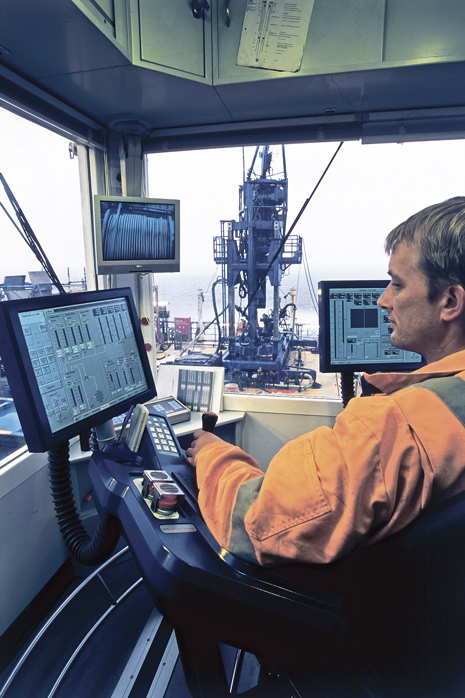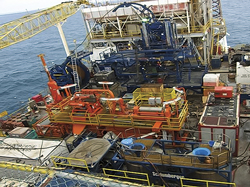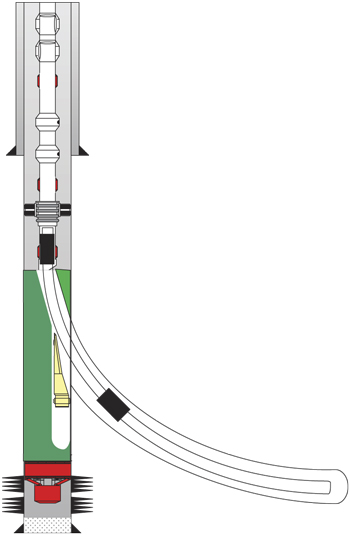NORHISHAM SAFFIN, AFIZZA ANIS ABDUL RAHMAN, NURUL EZALINA HAMZAH, NURFARIDAH AHMAD FAUZI, M. ZAIDAN KHALID and NALOM SYAIFULLAH, Petronas Carigali Sdn. Bhd; JOHN R. JENIE and HAITHAM EL HARIRY, Schlumberger
 |
| Coiled tubing drilling operations underway on a Petronas Carigali well in the South China Sea. |
|
The industry has experienced difficulty in establishing the use of coiled tubing drilling (CTD) in the offshore environment. Numerous one-off projects have been tried, but a commitment had not been made until now to test this method in a controlled way, to further the learning curve and realize the full potential of CTD offshore and in accessing bypassed reserves.
In the South China Sea, a pilot project was recently conducted with the primary objective of bringing proven technology to the offshore environment to access small, bypassed reserves economically and to offer an alternative to conventional drilling. The offshore environment of the South China Sea has a large number of candidates for this type of pilot on existing installations. Due to water depths and reserve locations, these candidates have required large, expensive rigs to drill or re-enter the wells. The demand for conventional rigs has forced rates to rise and also lowered availability, making the use of large conventional rigs difficult to justify economically for use in declining fields. From a technical standpoint, the wells can be accessed with coiled tubing to handle parameters seen regularly on these drilling projects.
 |
| Schlumberger coiled tubing operations taking place aboard a Petronas Carigali production platform. |
|
PILOT PROGRAM BACKGROUND
Petronas Carigali operates a vast network of oil and gas producing fields, facilities and infrastructures in the South China Sea. The network consists of more than 70 oil-producing fields and more than 40 gas-producing fields, specifically to satisfy Malaysia’s demand. The main producing fields, notably offshore Peninsular Malaysia, have been in production for an average of 15 to 20 years, from more than 100 platform structures.
Malaysia has experienced obstacles to achieving its objective of introducing a cost-effective development strategy for its mature offshore fields. Drilling a new well to access small hydrocarbon pockets has proven uneconomical, due to the requirement for offshore drilling rigs to drill or re-enter wells. The aging platforms and wells increase the risks and costs associated with safely draining hydrocarbons. Thus, the company opted to evaluate the use of an alternative drilling technology and techniques that involve minimum intervention on existing wells and facilities.
Re-entry drilling, using existing wellbores, was determined to be the best option to access these unexploited, compartmentalized reserves, and CTD applications were evaluated. This pilot project objective was to help the company maximize ultimate oil recovery by adding new drainage points in the existing main producing reservoir by tapping directly into the undrained/bypassed reserves with reduced time and costs to achieve targets.
CANDIDATE SELECTION
To ensure a high level of success desired for this pilot project, the selection criteria were based on similar projects in other parts of the world. The criteria were:
-
A remaining reserves limit greater than or equal to 0.5 MMstb
-
Field maturity and accessibility to areas/pockets of undrained reservoir
-
Formation thickness greater than, or equal, to 10 m
-
Reservoir target reachability less than, or equal to, 1,000 m from kick-off point to landing depth
-
Completion tubing size greater than, or equal to, 3½ in.
-
Mechanical condition of existing tubing
-
Platform condition and structural integrity.
From two fields in Area A, there were, initially, a total of 17 wells that met the first screening criteria. These wells were subjected to further assessment. They were divided into three types of completions to dictate the complexity of the casing exit operations:
-
Thru-tubing and set in casing exit
-
Tubing exit with monobore whipstock
-
Dual completion, exit through short string and casing.
The reservoir team considered a few target formations for the candidate pool, and with those formations, the vertical depth requirements allowed estimation of where the well would be exited for accessing the target zones.
The selected wells had 3½-in. completions; therefore a 2⅜-in.-OD, wired CTD bottomhole assembly (BHA) was chosen. Solids-free mud was chosen for the pilot project. Four wells in two fields were planned to be drilled in the South China Sea. Key objectives for each well were divided into several categories: window milling, drill build and tangent section, open-hole logging, completion and well reinstatement.
CASE HISTORIES
Well #1. The first well was selected in a larger platform to reduce the potential set-up issues, due to first mobilization. The existing well configuration was 3½-in. tubing and a target kick-off point (KOP) was inside 4½-in. casing, requiring the thru-tubing whipstock to set inside 4½-in. casing, Fig. 1. The plan was to set the cement plug on the existing perforation in 4½-in. casing and leave top-of-cement (TOC) below the KOP. The single exit in 4½-in. casing was milled with a straight motor and speed mill. Trouble was encountered when starting milling, due to the whipstock setting position. A second thru-tubing whipstock with CTD BHA was set, and correct setting was confirmed. A leak-off test was performed and swapped to water-base mud prior to pulling out of hole.
 |
| Fig. 1. Pilot well #1 diagram. |
|
The first build drilling BHA was planned with 0.8° bent motor and bi-center 2.7-in. x 3-in. PDC bit. Upon drilling a 20-m openhole section, stuck pipe occurred with differential sticking as the prognosis. The annulus was displaced to lighter density fluid, and the pipe was freed. While drilling with lower equivalent circulating density (ECD), another stuck pipe incident occurred. It was freed, using the same method as before. It was decided to switch to synthetic-base mud to achieve lower ECD. Two more stuck pipe incidents were experienced, leading to hole pack-off. Total open hole drilled was 167 m.
Well #2. The second well in the pilot project was on a smaller platform with a different setup, due to crane capacity and layout. The existing well configuration was 3½-in. tubing and 7-in. casing. The perforations were in 7-in. casing, and between the upper and lower production packer. Planned KOP was above the upper production packer. The plan was to plug-and-abandon perforations with cement to provide isolation and then set a monobore whipstock, Fig. 2.
 |
| Fig. 2. Pilot well #2 diagram. |
|
The first run was drilled with a straight motor to eliminate the bottom lip. Milling went slightly deeper without signs of exiting the casing. It was corrected with 2.5° bent motor on a subsequent run, and successfully exited the tubing and casing. The build section was planned for 40°/100 ft using 2.5°/100-ft bent housing. During the build section, discrepancies on the toolface were noted, and the well trajectory was updated. Because it was determined that the bottom shale would be penetrated, a decision was made to place a cement plug in the open hole and re-do the build section. The build section was successfully landed with 60°/100-ft dogleg severity (DLS). Drilling continued, resulting in an open-hole section of 927 m. Three stuck pipe events were encountered.
Upon final completion, a completion string configuration with two swellable packers to isolate the gas zone with blank tubing and flush joint pre-drilled liner was run in hole to cover the oil zone. After 282 m of completion string inside the open hole, the CT was stopped for a few seconds and could not run further, due likely to differential sticking. A decision was made to release the liner, displace tubing with diesel and move to the next well.
Well #3. The third well was on the opposite side of the platform, and used only one production packer. This was an old well that was being side-tracked without pulling the completion. The new KOP was above the original production packer, resulting in the need for a dual-exit window. The dual-exit window included first a cut on the 3½-in. production tubing, and then another cut through the 7-in. casing. The completion below the KOP would have been plugged off, likely by placing a cement plug in the production tubing. Once the 3½-in. window was cut, the plug and the packer acted as barriers, preventing communication to the lower zone. It was necessary to place the cement plug across the existing perforation and cement packer above the production packer, prior to setting the monobore whipstock inside tubing, Fig. 3. The CTD package was placed into the tubing-casing annulus to ensure uniformity of the cement plug. The cement inside the tubing was milled to 20 m below the planned KOP. E-line was used to run the slimhole cement bond log (CBL) to evaluate cement bonding, which showed good results and the TOC was more than adequate to isolate the annulus. The whipstock was set using E-line CT and orienting BHA.
 |
| Fig. 3. Pilot well #3 diagram. |
|
Drilling the build section commenced slightly ahead of plan and a discrepancy on the projection angle landing point was realized, which prompted a change in the building of the BHA. After a few meters, the BHA was swapped to a lateral BHA to continue drilling to total depth (TD). Two differential stuck-pipe events were encountered and released. TD was called early, due to the hole becoming sticky, and it was difficult to initiate drilling beyond 3,100 m, MD. Total openhole drilled was 640 m.
Upon final completion, the string configuration was run in hole with two swellable packers to isolate the gas zone with blank tubing and a flush joint pre-drilled liner to cover oil zones. The completion run was smooth, but high friction was experienced at about 190 m from TD. A decision was made to release the liner and displace tubing with diesel, and move to the next well.
Well #4. This well, with 3½-in. tubing and the KOP inside 7-in. casing, proved to be the most challenging, due to the casing exit scenario required in the existing completion. The plan was to mill a no-go nipple, place the cement plug inside the 7-in. casing all the way to about 20 m inside the production tubing, drill the pilot hole, and set the monobore whipstock inside the pilot hole and then mill the 7-in. casing. Cement was pumped to plug existing perforations and provide support for the whipstock. A conventional CTU milled the cement inside the tubing until 34 m below the end of tubing, to ensure cement placement and isolation.
The CTU unit milled the remaining pilot hole to ensure that the whipstock placement would touch the 7-in. casing. The whipstock was set with CT and orienting BHA, as planned. The build section was planned with 35°/100-ft DLS. The build section was drilled and landed close to plan. It was followed by a lateral drilling BHA all the way to TD. Total openhole length was 603 m. No stuck-pipe incidents were encountered. The completion string assembly was comprised of two swellable packers and flush joint pre-drilled liners, with total length of 580.5 m, Fig. 4. The tubing was displaced with diesel prior to pulling out of hole.
 |
| Fig. 4. Pilot well #4 final completion. |
|
IS CTD VIABLE OFFSHORE?
With the lessons learned from this pilot project, CTD has been proven as an effective, alternative re-development option to access bypassed reserves in mature fields. Early and detailed engineering planning—including candidate well selection, basis of design, equipment selection and offshore structure/platform assessment—was critical to the high success rate of the project. The project also proved that the flexibility to make changes to the drilling program in response to operational challenges was required. This flexibility decreased the learning curve from one well to another, thus eliminating the chance of reoccurring problems in subsequent wells. Significant well-to-well improvements were experienced with this project, covering the drilling practices to the successful implementation of rare operations, such as the monobore whipstock being placed inside the cement pilot hole and cementing through the CT E-line job. 
|








